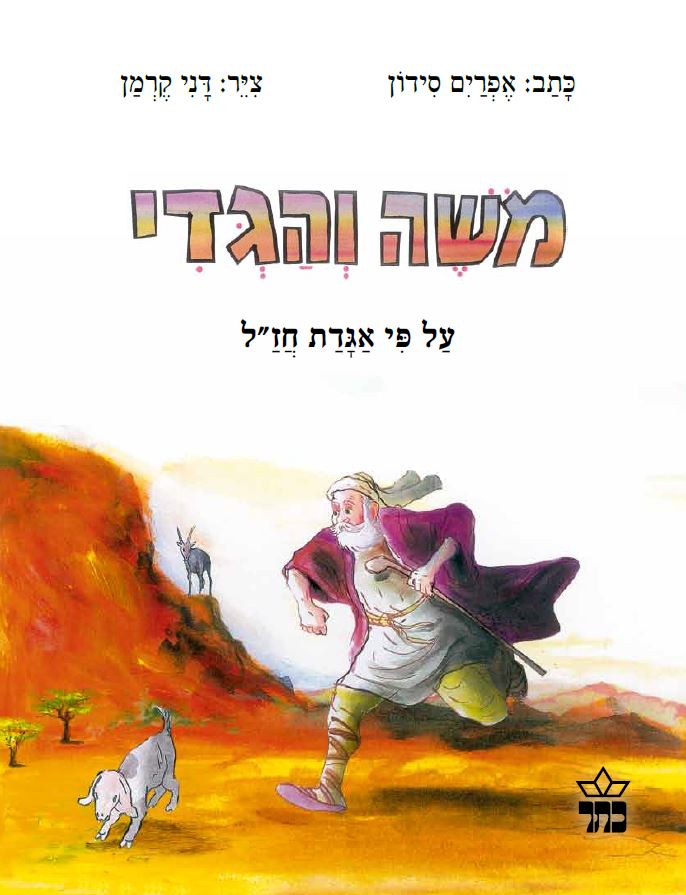Moses and the Baby Goat / By Ephraim Sidon
Illustrations: Dani Kerman
Dear Parents,
Where did the little goat run off to? Why did Moses chase after it with such unflagging determination? This story about Moses and the little kid, told in rhyme, is drawn from a Rabbinic midrash about Moses, and highlights the connection between being a leader and having compassion and care for the weak.
Who is a leader?
What do Moses, Rabbi Akiva, our Forefather Abraham, and King David all have in common? Before becoming leaders of our people, they were all shepherds! Many sources stress the similarity between caring for and leading a flock, and leading people. Concern for the needs of each and every single member of the group - even the weakest - has always been considered one of the qualities that make a leader. ThisMidrashic tale about Moses and the thirsty little kid, like other Moses stories, illustrates how even as young man, Moses showed his caring and concern for others – qualities thatlie at the very foundation of being a great leader.
We are all surrounded by people who are in need of help and attention. Moses’ story teaches us the importance of caring for our fellow human beings.
Happy reading!
Family Activities
- Have your children “read” the pictures and tell you the story, using the illustrations as their guide. You could pay particular attention to Moses’ facial expressions, and ask your children why they think he didn’t give up on one little kid, despite the fact that he had an entire large flock with plenty of goats?
- Even young children can be “big” and responsible! Help your children recall occasions when they were helpful to other children or small animals. Point out that even small, seemingly unimportant acts of kindness can be very meaningful for those in need; they also serve as a personal example for the entire “flock.” Afterwards, you could draw a picture together depicting one of the times when your children helped others.
- The story of Moses and the kid takes place in a desert. Are your children familiar with desert life – the different kinds of flora and fauna, the wells and oases, etc.? Have you ever visited a desert? Or perhaps you live in a desert area? You might go on a field trip, and compare the climate and scenery on your trip to that in the story.
- Look for the illustration that shows Moses carrying the little kid on his shoulders. Ask your children if they ever felt so tired that they asked to be picked up. Children often ask to be carried, even after they are big enough to walk on their own. You could discuss the times you carried them and the times they were able to walk independently. You could play piggy-back around the house, pretending to be Moses with the little kid.
- Many of our leaders started out as shepherds. Discuss the work that a shepherd does, and the qualities that go into making a shepherd. You could think together about how working as a shepherd helped Moses, when the time came, to lead the Israelites in the wilderness. Try to recall other shepherd-leaders in Jewish tradition (for example, King David and Rabbi Akiva).
- Moses struggles to catch up with the fleet-footed little kid. You could play “catch” together. First, you might play the role of Moses and call to the kid, “Little kid, stop. Little kid, come back!” while your children play the kid that “runs faster and faster.” Then switch roles. Who ran faster – you, or your children?
- What other stories and tales about Moses do your children know? After reading this book, you could tell the story of the Exodus from Egypt and the Israelites’ wanderings in the wilderness, and talk about the figure of Moses.
Have fun reading and talking about this book!
The Story of Moses and the Kid appears in Midrash Exodus Rabbah 2:2.
Our rabbis said: when Moses our teacher, peace be upon him, was tending Jethro’s flock in the wilderness,
a young kid ran off. He ran after it until he found it in a shady place,
where he saw a pool of water from which the kid had stopped to drink.
When Moses approached it, he said: ‘I did not know that you ran away because of thirst; you must be weary.’ So he placed the kid on his shoulders and carried it back.
The Holy One, Blessed be He,said: “Because you showed compassion while caring for a flock of mortal sheep, you will assuredly tend my flock, Israel.”





